 Matthew Cherry’s work is definitely a departure from our last few Spotlights. Utilizing 3D editing tools as well as the power of compositing, Matthew is able to recreate images in his head that would normally be out of reach for most average photographers, creating locations that don’t exist with props that cannot be found. Combining this flexibility with his knowledge of film and music history, Matthew creates imagery that recalls locations and moods of times past, and we’re grateful he took the time to talk with us about his photography.
Matthew Cherry’s work is definitely a departure from our last few Spotlights. Utilizing 3D editing tools as well as the power of compositing, Matthew is able to recreate images in his head that would normally be out of reach for most average photographers, creating locations that don’t exist with props that cannot be found. Combining this flexibility with his knowledge of film and music history, Matthew creates imagery that recalls locations and moods of times past, and we’re grateful he took the time to talk with us about his photography.
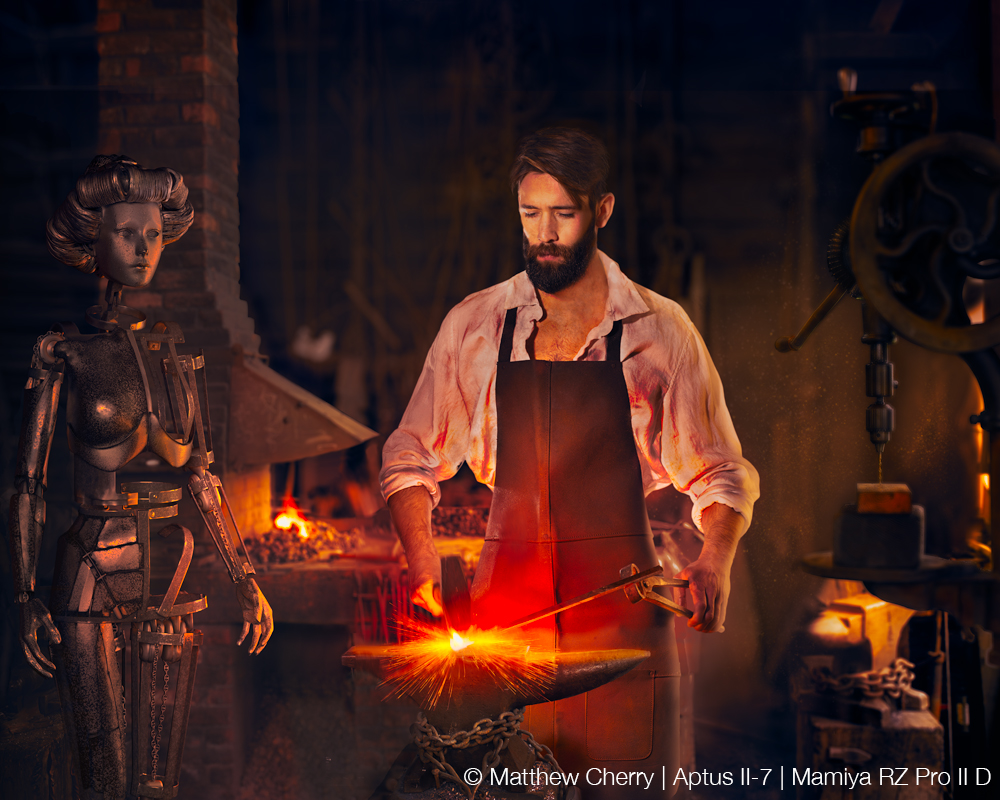
© Matthew Cherry | Aptus II-7 | Mamiya RZ Pro II D
You have an incredibly strong pulp cinema influence on your work, and you talk in your bio about how you draw inspirations from Italian and French Cinema, as well as American film noir and 40s/50s Jazz. Were you originally planning on being a cinematographer, or was the photography and cinematography hybrid the end goal?
My education was originally in music , I was a string bassist majoring in jazz performance, however, a congenital bone problem left me unable to play for any length of time soon after college. My minor was composition so I decided that I would get into film scoring and began working on some low budget student films. Well, if you know anything about student films, you know that everyone does everything, and I helped out as a gaffer, setting up the lights. They had no budget and the lighting instruments were basically a few old Moles augmented by some Home Depot work lights and the scenes looked horrible. I started building homemade modifiers for the lights, reading up on light design for stage and cinema, and talking to guys who had been doing it for a while and pretty quickly I was able to get some pretty nice looks with the light. The director liked this and asked me to do more. Then I started telling him how he should block his shots and shoot the story, to take advantage of that lighting and I wound up being the composer, gaffer and DP. After that experience I realized I had more fun (and possibly more talent) working with light than I did writing the score and decided to be a cinematographer. (Actually, I decided to be Fellini, but that didn’t work out.) As it turns out, it costs a lot of money to make movies – especially back then. To practice, I began working in still photography and once I saw what art photographers like Gregory Crewdson and Erwin Olaf were doing, that was it for me. Recently, I’ve gone back to doing some corporate video work and, once my new book is finished, I plan on adding some high-production motion work to my portfolio.
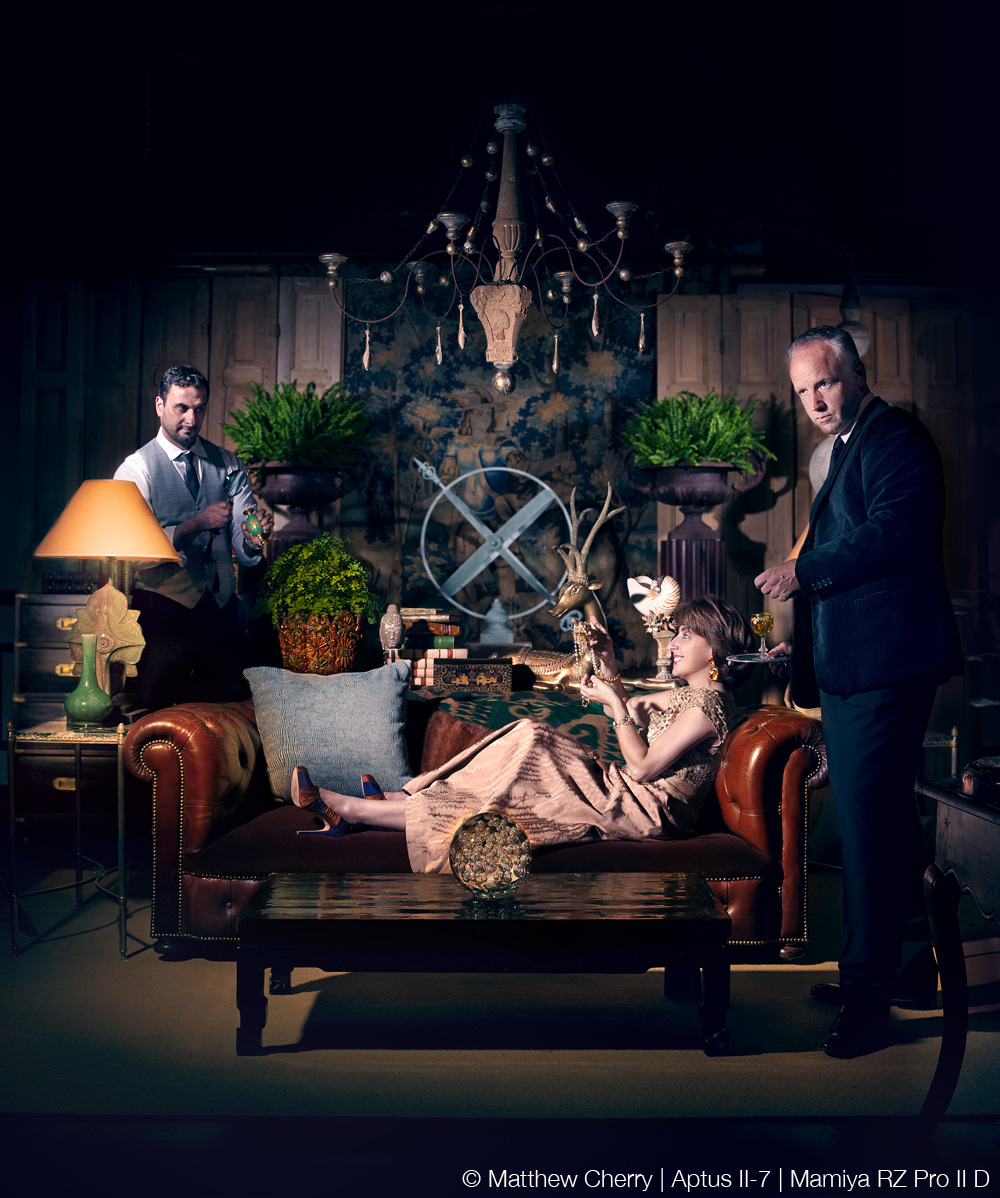
© Matthew Cherry | Aptus II-7 | Mamiya RZ Pro II D
The Hortus Illuminatus shots you did are gorgeous; it looks like a wider variety of techniques was used here, can you explain the inspiration and execution of these a little more in detail?
Thank you! These were actually done based on a bet I had with another photographer, which was the result of an argument over originality that may have been fueled by too many adult beverages. Essentially, his position was that there was really no point anymore as everything that could be done, had already been done. My position was that an artist’s individual voice created a nuanced view of a subject that imparted originality. I bet him that I could bring some bit of originality to any subject, and he took the bet. Then he told me the subject would be flowers – UGH! Flowers are probably the most painted/photographed subject matter of all time. At first it seemed like a bad bet, but eventually I threw out everything I knew or had seen about flowers, and went back to my core vision.
I believe that every artist is simply telling and retelling the same story over and over and over, they’re just exploring different facets of it and presenting it in different ways. The different works may look radically different on the surface, but the underlying themes remain constant (usually to whatever neuroses drives the artist). Without going into a full blown therapy session, my issues tend to deal with being raised on old movies and realizing, as a young adult, that the world I had hoped to become a part of no longer existed. So part of what drives me is the glamour and sophistication of the past, especially as seen through the lens of Hollywood. I used this as my intent when shooting the flowers. Essentially, I set up a table top studio that mimicked a black sound stage with a cyclorama. I then made my own lighting instruments using small flashlights, scrims, silks, gobos, flags cookies and bounce cards and lit the flowers the way George Hurrell or C.S. Bull would have lit the movie stars that graced their studios during Hollywood’s Golden Age. I think I was able to come up with something original, that had a bit of me in them, even with such an oft used subject matter. In any case, I won the bet.

© Matthew Cherry | Aptus II-7 | Mamiya RZ Pro II D
Why Capture Integration? What made you choose us?
I was looking for a digital solution for my RZ67 and, after seeing files from Hasselblad, Phase One and Leaf, was pretty sure I wanted a Leaf system. I hate small format cameras and love the system that is the RZ platform. CI had some used ones at a very good price, so I bought one, not thinking much about the company. I had some problems with that back on my camera and, after literally hours of conversation with various representatives of the company, wound up exchanging it for a newer (but also used) back. During this time there was a problem, not with their back, but with the adapter plate supplied by Mamiya and I had a commercial shoot coming up. The folks at CI literally shipped me a complete system that they had tested to work – A new RZ 67 ProIID, new back, new adapter plate, cables – EVERYTHING. This way, not only could I troubleshoot the problem with tech support on the line, I knew I had a working kit no matter what.
I was simply blown away by this level of customer service. When I had a question, Dave Gallagher, the owner, literally spent whatever time was necessary talking me through the process. In my 25 years of business, Capture Integration has the best customer service of any company I’ve ever dealt with, regardless of product or industry. I made my first purchase because of price, but I’ll make all my future purchases there because of the support you offer and your obvious commitment to customer satisfaction.
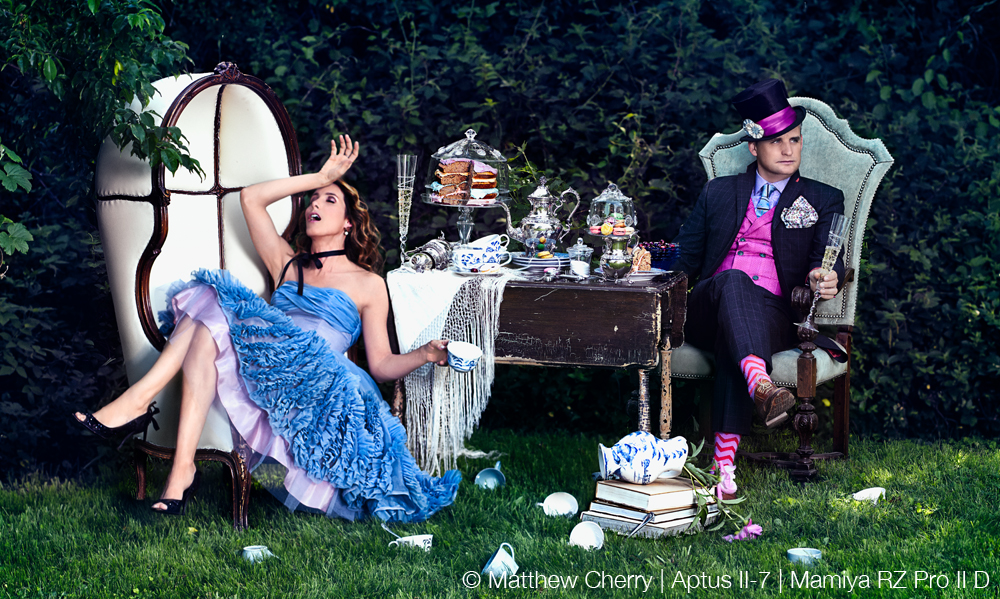
© Matthew Cherry | Aptus II-7 | Mamiya RZ Pro II D
You’ve got the usual spate of social media buttons at the bottom of your webpage; how do you feel engaging on various platforms has changed your business? Have you seen a measurable increase in business or requests for a certain type of work given something you put up on Facebook or tumblr?
Somewhat. I see it more as a branding and marketing tool rather than a sales tool. I’m in the process of completely reinventing my brand, including an all new portfolio, of which there will be three when I’m finished. This is a long process that takes at least a year, if not two to complete. I knew I had enough work from existing clients to carry me over, but I still did not want to simply disappear from the market for all that time. Social media allows me to do the rebranding and new portfolio builds while still engaging my market and making inroads into new ones.

© Matthew Cherry | Aptus II-7 | Mamiya RZ Pro II D
You use a lot of compositing in your photography, and on your blog you got more in depth with what kind of 3d modeling you use for your shoots. Do you find yourself incorporating this technique more and more into your commercial work?
It’s funny, I’m actually very much of a traditionalist at my core, preferring to work with large format film whenever possible. In fact, I still maintain my own darkroom for personal work – it is here where I am the happiest and find the most personal satisfaction. The commercial world, however, has fully and firmly transitioned, not only to digital photography, but also to 3d modeling and rendering. At first, I was somewhat resistant to this, but then I saw the possibilities for what they were and have become very excited about what I can do moving forward. I love working with large physical sets and building them out, but some scenes are simply too ambitious to realistically build out, either due to space or cost restrictions. For example the Opera scene that we recently shot, would have taken months to build and prop on a proper soundstage and would have cost thousands of dollars to build. I would not be able to justify that kind of expenditure for a portfolio shot, but can justify the time required to build the set virtually. We are in production right now for another shot that takes place in a recreation of King Tut’s tomb (with a bit of creative license thrown in), again, it would not be possible without the ability to create a photorealistic virtual set.
As part of my rebranding effort, I wanted to create a promotional series that would go out to Art Directors and Creative Directors at national brand and advertising agencies. The goal was for an engaging series that was fun, highlighted the various talents of my team and demonstrated to them the kind of art direction and compositing work that they require on a daily basis.
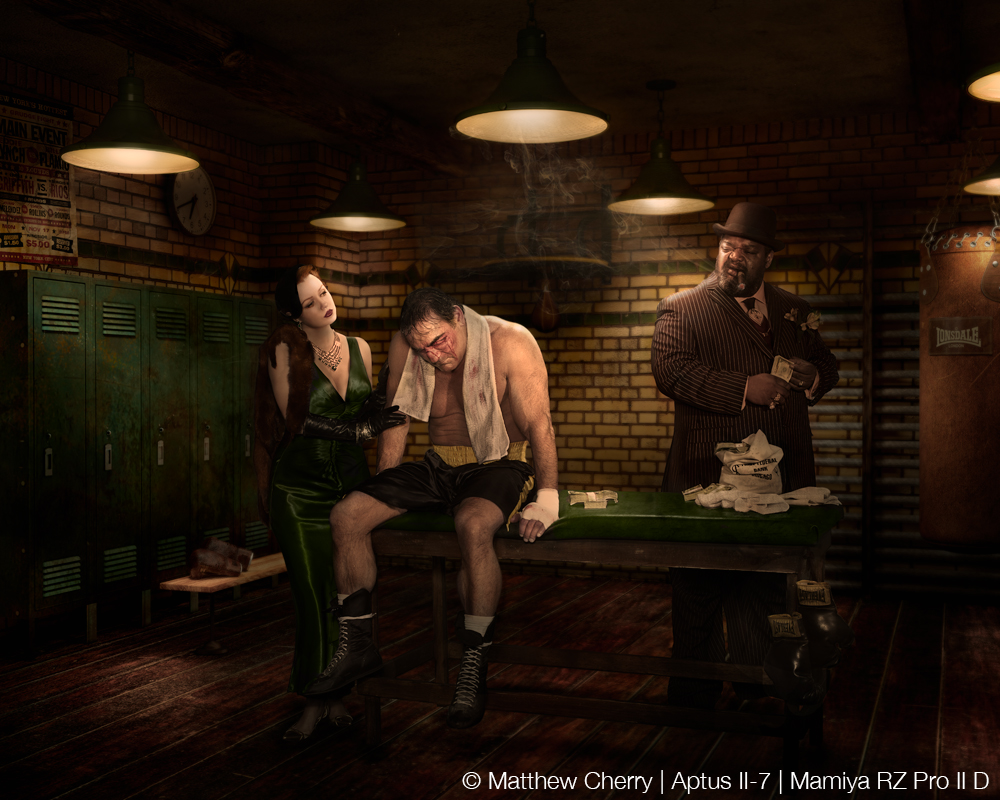
© Matthew Cherry | Aptus II-7 | Mamiya RZ Pro II D
What’s currently in your bag? What are you shooting with, what are the go to essentials on your sets, or even for when you’re editing or lighting?
I have a large Pelican case with a full RZ kit including two RZ67 ProIID bodies, a Mamiya DM33 Digital back, most of the lenses Mamiya made for the system, as well as most of the other accessories that Mamiya made for the system, including the G3 lens hood, which I use all the time. I only wish that it took 4×4 filters instead of 3×3 and I sometimes put a cinematographers matte box on the camera to use my full collection of filters. I switch between the WLF and the Metered prism depending on the kind of shoot I’m doing and will often use the motor winder as well. Of course, I still shoot a ton of film, so I have quite a number of film backs for the camera as well. In studio I shoot tethered into Capture One Pro so there’s a Macbook Pro and additional peripherals required to make that happen.
My camera “bag” is actually a fairly small part of what we bring to any location. It’s really my various tool/gaffer bags that are loaded up. Scrims, cookies, lost of cinefoil, gels, foamcore, flags, silks, TONS of Manfrotto super clamps, c-stands, spreader clamps, apple boxes, high-hats, etc. I tend to light with a lot of smaller, harder light sources to get the look I’m after. So, for example, even though the “Hello, Johnny….” shot at the vanity might look simple, there were actually ten lights used on set to light the scene. Once everything’s been shot, the initial photo correction work is done in Capture One and then everything else is done in Adobe Photoshop.
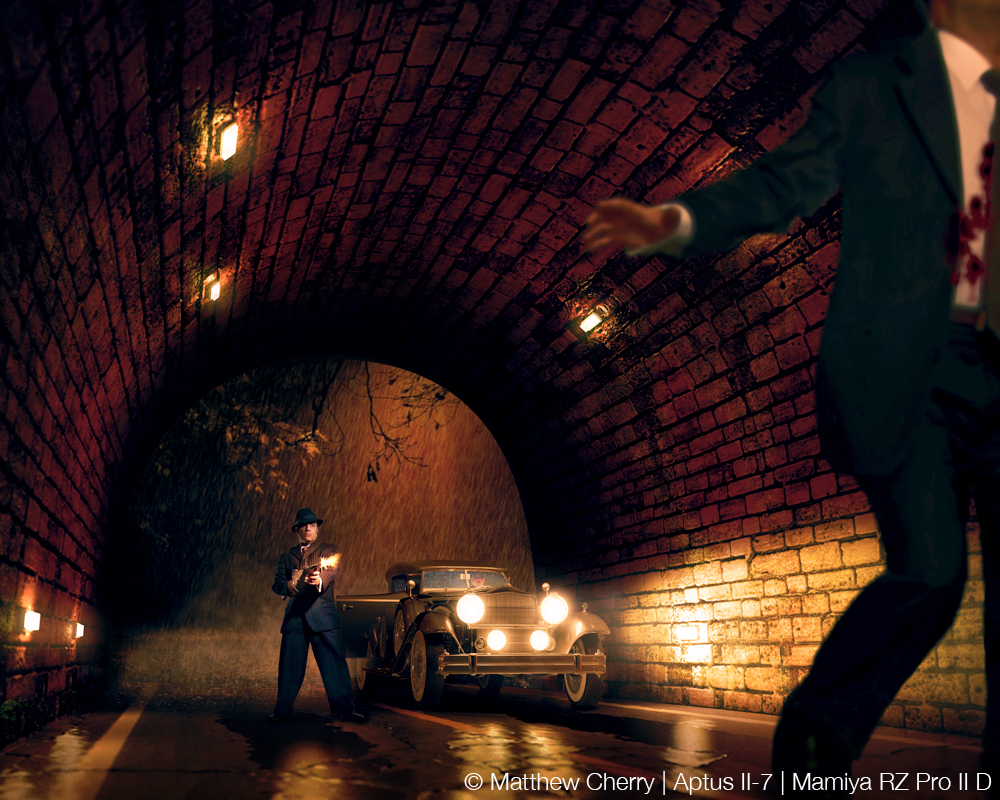
© Matthew Cherry | Aptus II-7 | Mamiya RZ Pro II D
You posted a behind the scenes of your work exhibited at Art Basel; how do you like going to those bigger show events with the rise of social media “curation” and blog series and shows? Do you feel there’s still a place in this world for hard physical output with so much digital work out there?
I enjoy the larger shows, the first one I exhibited at was Art Chicago and they put on a great event, as does the Armory in NYC – but nothing compares to Basel. The shear volume of amazing art from all over the world is amazing to witness. While the smaller shows and blog series are great, there is something to be said for standing in front of a work and seeing it as the artist intended it to be seen. It’s an entirely different experience, at least for me.
I do, most definitely, believe there is still a place for physical works of art – just as, in the art world, there is still a very strong place for film and traditional printing processes. But, as someone who thinks it all went downhill after the decline of the French Academy, I may not be the one to ask… But, seriously, there is a place for tastemakers and there is a place for academic understanding of art, and there is a place for artists who have a point of view and engage in such work. I know I’ll sound like a snob for saying this, but the so-called democratization of art (in our case the explosion of digital photography) has been as much of a curse as a blessing, often strengthening the divide between art and commerce.
The pedagogy that accompanies this mindset has been hurting photography for a while now. When one wants to begin their academic pursuit of photography they are generally asked flat out “Do you want to be an artist, or do you want to be a [working] photographer?” How one answers that question determines the path they will be sent to embark on and the two paths are radically different. As a result, you have students graduating with an MFA (the art path) with so little in the way of technical knowledge, they aren’t even equipped to assist a commercial photographer, and you have students graduating from largely technical schools with no real understanding of, or appreciation for, the arts in general and the cannon of photographic art specifically and have almost no understanding of art direction. It is, in my opinion, a very misguided approach – art photography suffers from a lack of technical sophistication and commercial photography suffers from a lack of artistic sophistication. I have been working on a series of workshops, and a book, on creating the cinematic image. I’m often struck by students whose only questions are regarding equipment, never giving much thought to art direction or artistic expression, which is specifically what I’m hoping to address.
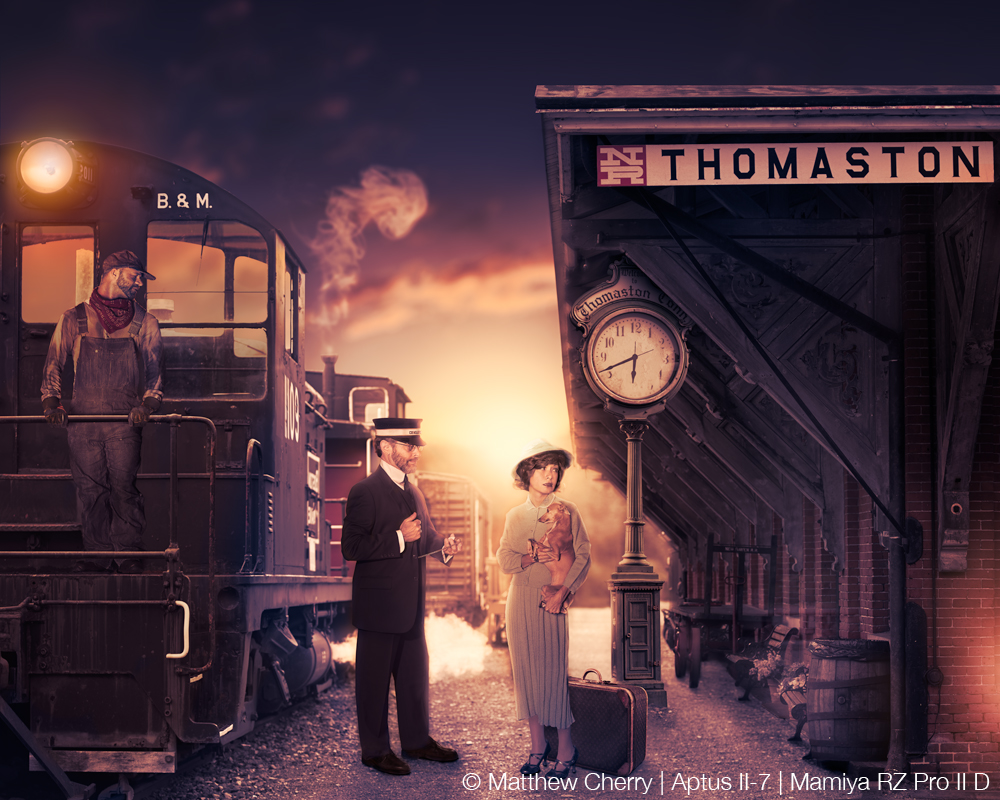
© Matthew Cherry | Aptus II-7 | Mamiya RZ Pro II D
I enjoy that you posted a while back about the Sex Kittens album cover feedback you received from friends and family; controversy and thought provoking imagery is increasingly hard to find in our homogenized industry as time goes on. Do you find yourself able to push the boundaries more due to your strong fine art background as well as the historical influences you have? Or is it something you see increasingly being relegated to your personal work?
It is increasingly hard to find, and part of that has to do with the democratization of art that we just discussed. If you feel your work (and this goes for Art Directors and Creative Directors as much as photographers) has to appeal to everyone, to not offend anyone, then that leaves you with very little to explore. Ultimately, if you try to appeal to everyone, you wind up truly appealing to no one. I’ve been in business for 30 years, and I certainly understand that in the commercial world, creative exists, ultimately, to market and sell goods and services. That’s fine and I enjoy doing it. However, we still need to stay relevant as artists, and that means having a perspective on life that we aren’t afraid to discuss. It means being able to make artistic statements about the world around us without fear of retribution. This is more difficult in a society that is as binary as ours has become – where merely depicting a facet of social reality implies that you are a proponent of it. That has never been true with art, and it’s only deemed to be true now because those who know nothing about art are given equal weight in the conversation with those who do. This is the curse of the democratization of art. Not that art should be for only a rarefied few, I reject that notion, just as I reject that only professional commercial photographers can produce the best work, but the creation of art should not be governed by those who neither understand or appreciate it.
Having said all of that, I do think having a grounding in the arts allows you to push boundaries more. Not simply because one calls themselves an artist (although, admittedly, it helps) but rather that having a grounding in the arts allows you to push boundaries in a better way. Simply being shocking isn’t enough, you need to say something, and when you really delve deep into what you’re trying to say, you find that you take a more nuanced approach that leads to discussion. That photo did cause some controversy, but it sparked quite a bit of intelligent conversation about gender roles in society. I think that was a good thing.
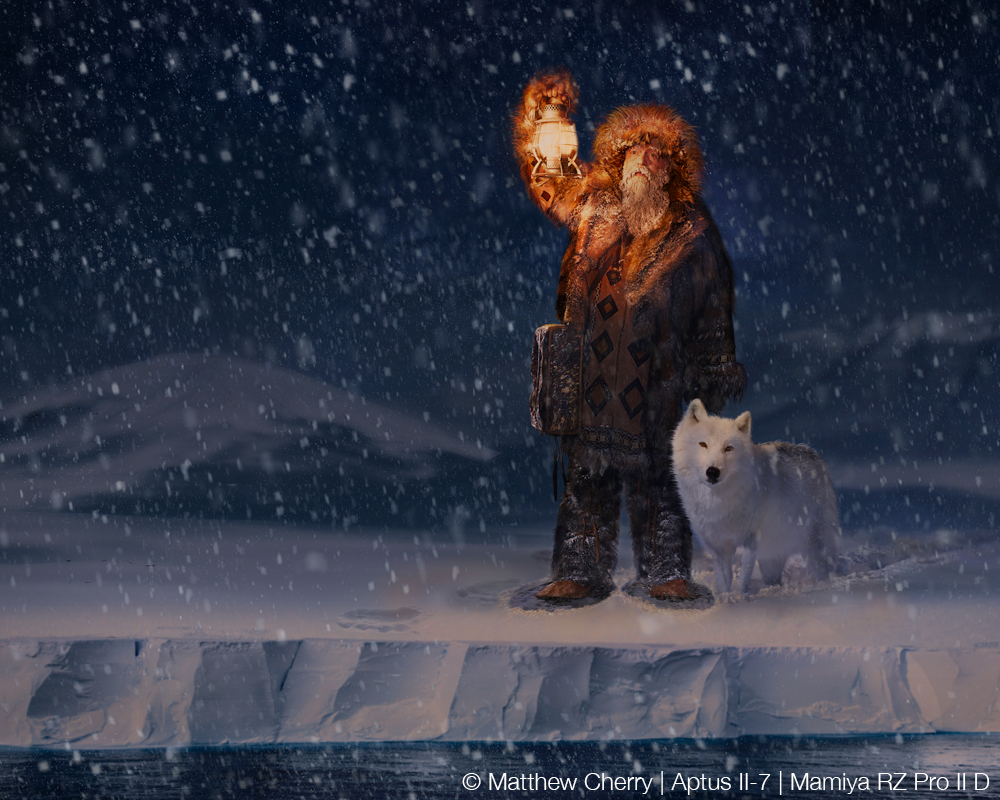
© Matthew Cherry | Aptus II-7 | Mamiya RZ Pro II D
I see that you’re still shooting film for some fun work, do you ever find yourself using any of your digital backs or cameras on view camera standards? I know in my personal work with film or digital I kind of get different head game for each method. Is it something where you find the mediums interchangeable, or do you feel like there’s a definite different mindset shooting between the methods?
I don’t know if I’d refer to it as “fun work” but I do get your point. I have used the digital back on a 4×5 camera for product work but, honestly, if I’m going to shoot a view camera, I’d rather shoot film. I do think the tool informed the work, but it’s knowledge that is transferable. There is a lot that you can learn by using a view camera that will make you a better photographer, no matter what your main camera is. I’ve never liked small format cameras, I’m sure that is due to how I like to work, the camera simply isn’t a good match for the work I like to create. If I were shooting documentary footage in developing countries, I probably wouldn’t be a fan of my 11×14 studio camera.
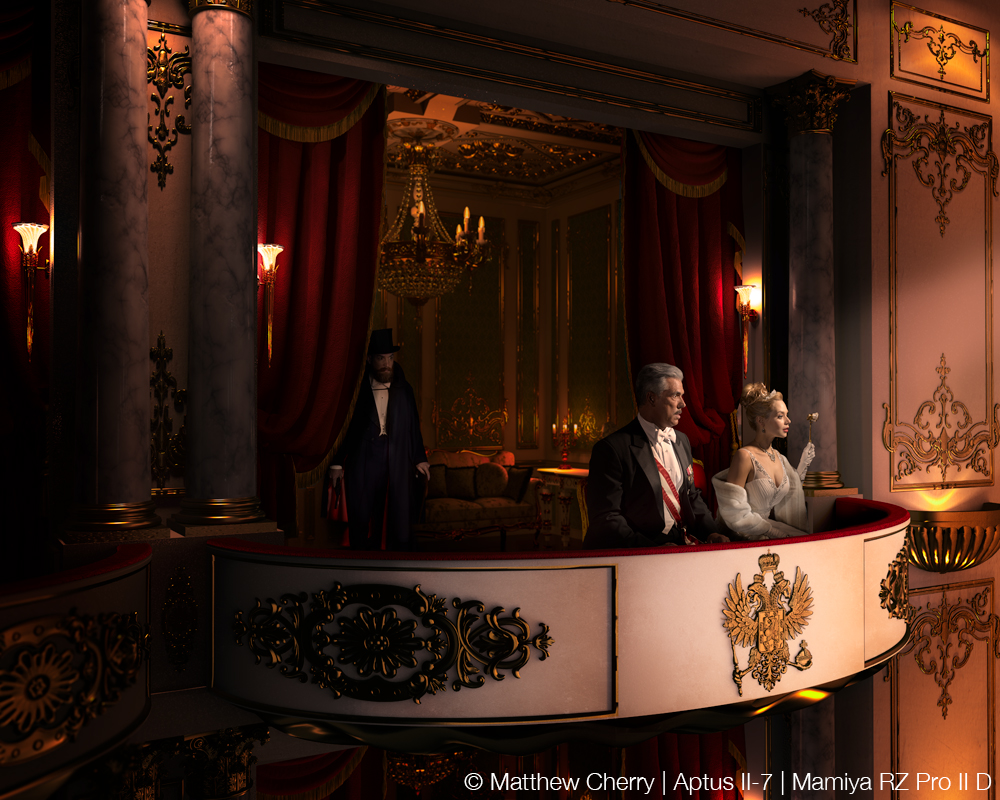
© Matthew Cherry | Aptus II-7 | Mamiya RZ Pro II D
What would you want to see next in the industry? Any big changes to your gear or photography that you want to see in the next year?
I love the look of the new Phase One XF – so happy to see they brought back the WLF!
But here’s what I really want (and why you should want it too):
Every year at Christmas, the lapsed Catholic in me goes to church and lights a candle hoping for one wish – a full 6×7 sensor. I don’t care if it’s only 40mp. All we hear about is resolution, and that’s fantastic – as an art shooter, more is almost always better (given the trend for large prints). But the reason for shooting medium format has always been for the look as well as the resolution, and that “look” really starts at or above 6×6. Yes, it’s present in the full frame 645 sensor, but that was always a compromise format. Phase One should bring out a true 6×7 sensor and make the world a better place! They already have perhaps the greatest camera system ever designed still in production that could use it. The RZ glass with a digital back is simply breathtaking to see, matching or surpassing any other lenses that are available. The sharpness, color and contrast is simply amazing. If we want MFD to continue (and I certainly do) then it needs to be more than just a slightly soupped up DSLR. As DSLR chips are improving, the advantages to MFD get smaller and smaller. We need a new standard for MFD and I firmly believe that would be better achieved by focusing on size and bit depth, rather than simply offering more and more, smaller and smaller, pixels.
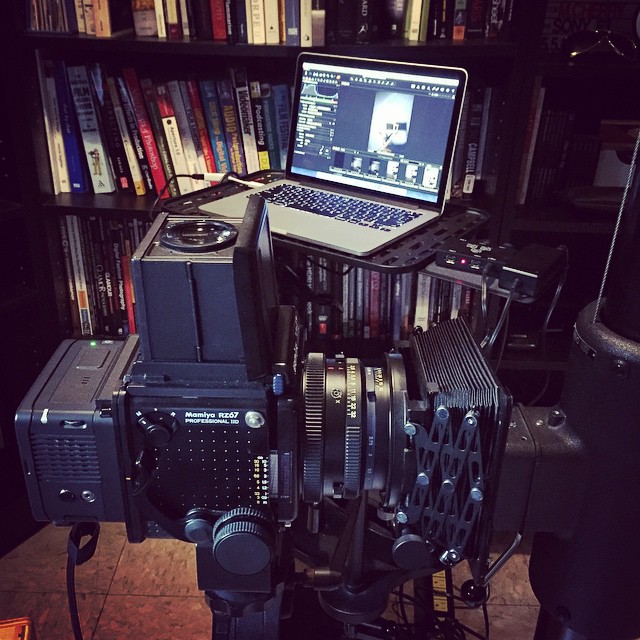
You can see more of Matthew Cherry’s work below:
Website: http://matthewjcherry.com/
tumblr: http://matthewjcherry.tumblr.com/
Twitter: https://twitter.com/MJCStudios
Facebook: https://instagram.com/mcstudios/